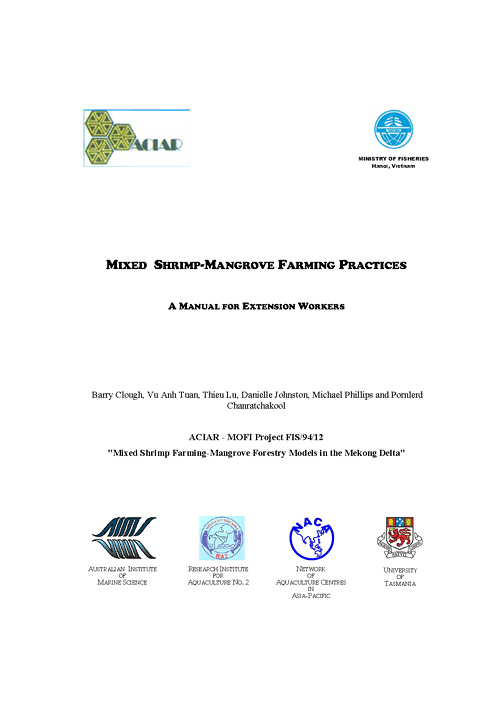Mixed shrimp-mangrove farming practices: A manual for extension workers
17 September 2005 | Barry Clough, Vu Anh Tuan, Thieu Lu, Danielle Johnston, Michael Phillips and Pornlerd Chanratchakool | 979 Downloads | .pdf | 1.09 MB | Better management practices, Livelihoods, gender and social issues, Aquatic plants, Environment and Sustainability, Education and Training, Vietnam, Water quality
This manual has been prepared to assist extension officers to advise farmers on techniques for improving yields and farm income in mixed shrimp farming-mangrove forestry farming systems in the Mekong Delta. It focuses mainly on simple, common sense techniques that will allow farmers to make step-by-step improvements to production without taking unnecessary risks.
The techniques and recommendations covered in this manual are based on the experience of a 6-year collaborative research and development project between the Governments of Vietnam and Australia. It was supported mainly through the Fisheries Program of the Australian Centre for International Agricultural Research (ACIAR).
Assistance in evaluating and refining this manual was provided by extension officers in the southern provinces of Caàn Thô, Bac Lieâu and Caø Mau in Vietnam, and by farmers in shrimp-mangrove farming enterprises in Ngoïc Hieån district of Caø Mau Province. The editors gratefully acknowledge the assistance of Nguyeãn Vieät Hoaøng, Leâ Coâng Uaån (farmers), Tieàn Haûi Lyùï (Bac Lieâu Extension Center), Cao Phöông Nam (Caø Mau Department of Science, Technology and Environment), Tröông Hoaøng Minh (Caàn Thô University), Nguyeãn Thò Phöông Lan (SUMA Project), Ñaëng Coâng Böûu (Caø Mau Wetland Forest Research Center), Nguyeãn Vaên Duyeân (Caø Mau Department of Fisheries), Ñoã Vaên Hoaøng (Caø Mau Sub-Institute for Fisheries Research) and Ngoâ Vaên Haûi (Caø Mau Sub-Institute for Fisheries Research).
Freehand illustrations were drawn by Lyù Cao Taán, and photographs and computer illustrations were provided by Danielle Johnston, Barry Clough and Vuõ Anh Tuaán.
Creative Commons Attribution.

